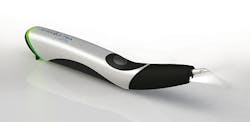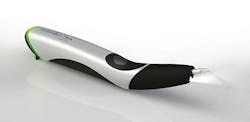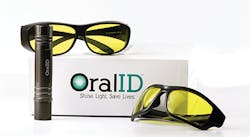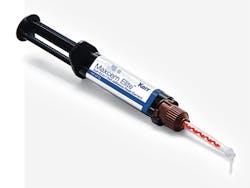Pearls for your Practice
Joshua Austin, DDS, FAGD
EndoUltra by Vista Dental Products
We all know how "hit and miss" endodontics can feel sometimes. We've all seen radiographs of teeth with awful endodontic therapy that are totally asymptomatic and have no signs of periapical pathology. We've also all seen teeth with beautiful-looking endo and a huge periapical radiolucency. What's the deal? Is endodontics like voodoo?
The full answer is probably too complex and multifactorial to be fully understandable. What the data does say, however, is that preoperative diagnosis is one of the most important factors in determining potential endodontic success. In addition, we know that irrigation is the key to debriding and disinfecting the root canal system. I like to have every tool possible that could increase my chances for success.
The EndoUltra by Vista Dental seems to be a great addition to the endodontic tray setup. The EndoUltra is a cordless ultrasonic handpiece used to agitate your irrigant of choice within the canal system. This ultrasonic agitation has been shown in studies to lead to an increase in biofilm disruption and removal of dentinal debris. The 40 kHz vibrations resonate down the entire length of the tip, producing "acoustic streaming and cavitation" of intracanal irrigants, according to the manufacturer. In addition to providing additional cleansing power, this also enhances the clinician's ability to negotiate tough anatomy. When you power on the EndoUltra, the tip is moving so fast that it doesn't even look like it's moving. I held the tip against my fingernail and could see marks being left on it from the vibrations. The battery is rechargeable and should last several cases before needing to be recharged. It will give you an orange light warning, so you know when it's time to plug it in. (It won't just go dead on you.) The autoclavable tips are size 15 with a .02 taper, making them usable in almost any case, and the unit also comes with a tip bender to help you achieve the perfect angle for sneaking the tip into any canal.
Using the EndoUltra couldn't be easier. Go through your endo procedure as you normally would. At the time of the final irrigation, flood the chamber and canals. Power on the EndoUltra and activate the tip. Slide the tip into the canal and down, within a couple of millimeters from the working length. Move the activated tip with a small vertical motion for 30 to 60 seconds. Aspirate and dry your canals as you normally would; then obturate with the method of your choice.
This extra step could be hugely beneficial for necrotic teeth, for which canal debridement is of vital importance for endodontic success. I think this makes a great addition to your armamentarium if you do any type of endodontic procedures in your office. It's simple to implement, science supports it, and it will allow you to better debride the canals you are working on. Solid double to the gap for Vista Dental!
OralID by Forward Science Technologies
I think it's safe to say that we, as oral health clinicians, would prefer to catch oral lesions earlier and with more accuracy. Over the past decade, some manufacturers have claimed that their adjunctive tools could aid clinicians in soft-tissue exams and oral-health screenings. Most of these adjunctive tools have been extremely costly and have required some sort of disposable element, such as a rinse or a swab, for each patient. A piece of small equipment that costs thousands of dollars but does not enhance production is probably not a top item on most dentists' wish lists. Finding a reasonably priced adjunctive tool that eliminates disposables has been an interest of mine for awhile. After using OralID for the past six weeks, I think it's the answer.
There is definitely a bit of a learning curve in figuring out what you should be looking for when using the OralID. Due to this, Forward Science Technologies provides a nice online training module with a live member of their clinical staff who helps. You really just need to start using it to look at oral tissue.
OralID uses a blue light at 435 nm to 460 nm that causes soft oral tissue to fluoresce. The device comes with special glasses that have a yellow filter, which allows the clinician to easily identify areas that do not fluoresce. Suspicious areas are those that appear dark under the light of the OralID but not under visual inspection. Unlike some other products, no rinsing or swabbing is needed before the exam. This diminishes the per-patient cost of the device and eliminates the need for rinses and swabs, which are distasteful and cumbersome in practice. The OralID light does, however, require replaceable batteries. They aren't a very common size (CR123A), so you will need to make sure you have extras in stock for when they run out.
Also included in the kit is a filter for your smartphone camera called the SmartFilterID. If you do encounter a questionable area, snap the SmartFilterID onto your smartphone's camera and take a snapshot of the suspicious area. Then, the next logical step would be to figure out what the area is histologically. You can use the photo as a reference for monitoring an area or as part of a referral to a specialist. It's a nice accessory and has come in handy a few times for me.
A couple of cytology kits, called CytID, are included with the OralID kit. CytID is a cytology swab kit that will allow you to noninvasively collect a sampling of cells as a precursor to confirm the need for a full biopsy. The cytology sample can be tested for human papillomavirus (HPV)-something that we should be thinking more about these days.
OralID has been a handy adjunct to my eyes, offering a good bright light for soft-tissue examinations. Just like a caries-detecting dye, learning how to read what you see will require practice. After some experience with the OralID, I have easily integrated it into routine exams. It's important to remember what this is: It's a screening tool, so it won't replace the need for you to think and process what you see. With a reasonable cost and no disposable costs, it's a soft double down the line for Forward Science on the OralID!
Kerr's New & Improved Maxcem Elite
My father was an excellent restorative dentist who practiced in his prime during the 1970s. Oftentimes, I think with great envy about the dental materials that he needed to keep on hand. He needed one type of cement: zinc phosphate. That's it-zinc phosphate for full-gold crowns, zinc phosphate for gold onlays, zinc phosphate for porcelain-fused-to-metal crowns (PFMs). I think many clinicians yearn for this kind of simplicity. Although I feel that cementing does not have a universal solution, I also believe we have some good cement options for many of the indirect restorations we do. One of these products is Kerr's Maxcem Elite cement, which was recently reformulated.
The New & Improved Maxcem Elite is a self-etch, self-adhesive, dual-cure resin cement that comes in an auto-mix syringe with four available shades: clear, white, white opaque, and yellow. So what's up with the "New & Improved" part? The biggest improvement seems to be higher bond strength to both enamel and dentin. In fact, independent studies show that the bond strength is nearly doubled from the previous formulation.
Shade stability is a selling point that Kerr makes in their literature, but only time will tell how valid that claim is. Another big selling point in Kerr's marketing materials is easy cleanup, and this one is certainly true. Excess cement tends to peel off in one clump, which is really nice.
Back to simplicity. Can Maxcem Elite be the only cement in your office? Sure ... if you want. I think Maxcem Elite is a great choice for posteriors with adequate clinical crown length, but I still prefer other options for bonding veneers and crowns with short clinical crowns. With that being said, Maxcem Elite is a solid choice for your workhorse everyday cement, and its cost is consistent with those of its in-class competitors. New & Improved Maxcem Elite is a solid single up the middle. It's not going to revolutionize your practice, but it is a nice resin cement that cleans up easily and that you can use day to day.



